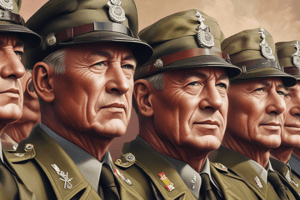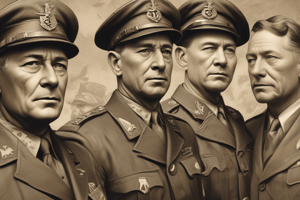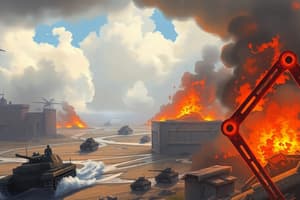Podcast
Questions and Answers
Who served as the President of the United States during WWII?
Who served as the President of the United States during WWII?
- Adolf Hitler
- Franklin D. Roosevelt (correct)
- Winston Churchill
- Joseph Stalin
Joseph Stalin signed a non-aggression pact with the Allies before becoming their partner.
Joseph Stalin signed a non-aggression pact with the Allies before becoming their partner.
False (B)
Which country did Benito Mussolini lead during WWII?
Which country did Benito Mussolini lead during WWII?
Italy
The leader of Nazi Germany during WWII was __________.
The leader of Nazi Germany during WWII was __________.
What was a major focus of Winston Churchill's leadership during WWII?
What was a major focus of Winston Churchill's leadership during WWII?
Hideki Tojo was responsible for Japan's expansionist policies in Asia and the Pacific.
Hideki Tojo was responsible for Japan's expansionist policies in Asia and the Pacific.
What major event prompted the USSR to join the Allied forces?
What major event prompted the USSR to join the Allied forces?
The __________ Pact was an agreement between Nazi Germany and the Soviet Union at the beginning of WWII.
The __________ Pact was an agreement between Nazi Germany and the Soviet Union at the beginning of WWII.
Match each leader with their respective country:
Match each leader with their respective country:
What major challenge did wartime leaders have to manage alongside military efforts?
What major challenge did wartime leaders have to manage alongside military efforts?
Which leader showed unwavering resolve during the Blitz in the UK?
Which leader showed unwavering resolve during the Blitz in the UK?
The United States maintained an aggressive stance before the attack on Pearl Harbor.
The United States maintained an aggressive stance before the attack on Pearl Harbor.
What was the significance of the Japanese attack on Pearl Harbor?
What was the significance of the Japanese attack on Pearl Harbor?
Stalin's leadership on the Eastern Front involved mobilizing vast resources to defend the __________.
Stalin's leadership on the Eastern Front involved mobilizing vast resources to defend the __________.
Match the following leaders to their respective actions during WWII:
Match the following leaders to their respective actions during WWII:
What was a controversial decision made concerning Japan during WWII?
What was a controversial decision made concerning Japan during WWII?
The actions of global leaders during WWII had little impact on the course of the war.
The actions of global leaders during WWII had little impact on the course of the war.
What blend of strategies characterized Stalin's leadership during the Eastern Front?
What blend of strategies characterized Stalin's leadership during the Eastern Front?
The choice to use atomic weapons against Japan involved considerable __________.
The choice to use atomic weapons against Japan involved considerable __________.
What was the primary focus of leadership decisions during WWII?
What was the primary focus of leadership decisions during WWII?
Flashcards
Churchill's leadership during the Blitz
Churchill's leadership during the Blitz
Churchill's leadership during the Blitz was critical in maintaining British morale and encouraging resistance against Nazi Germany.
Stalin's leadership on the Eastern Front
Stalin's leadership on the Eastern Front
Stalin's leadership during the Eastern Front involved a combination of strategic planning and mobilizing resources to defend the Soviet Union against the Nazi invasion.
Pearl Harbor's impact on US leadership
Pearl Harbor's impact on US leadership
The Japanese attack on Pearl Harbor marked a significant turning point in US involvement in WWII, shifting the nation's stance from isolationism to active engagement.
The atomic bombing decision in WWII
The atomic bombing decision in WWII
Signup and view all the flashcards
Leaders' role in WWII
Leaders' role in WWII
Signup and view all the flashcards
Franklin D. Roosevelt
Franklin D. Roosevelt
Signup and view all the flashcards
Winston Churchill
Winston Churchill
Signup and view all the flashcards
Joseph Stalin
Joseph Stalin
Signup and view all the flashcards
Adolf Hitler
Adolf Hitler
Signup and view all the flashcards
Benito Mussolini
Benito Mussolini
Signup and view all the flashcards
Hideki Tojo
Hideki Tojo
Signup and view all the flashcards
Shifting Alliances
Shifting Alliances
Signup and view all the flashcards
National Priorities
National Priorities
Signup and view all the flashcards
Domestic Politics and War Efforts
Domestic Politics and War Efforts
Signup and view all the flashcards
Mobilization
Mobilization
Signup and view all the flashcards
Study Notes
World Leaders During WWII
- Franklin D. Roosevelt (US): Served as President throughout the war, initially focusing on containing the conflict but increasingly committed to actively supporting Allied forces. Known for his leadership in mobilizing the US economy and military.
- Winston Churchill (UK): Prime Minister of the UK, a key figure in the early stages of the war. Formally aligned with the US and other Allied countries. Characterized by strong rhetoric and resolve against the Axis powers.
- Joseph Stalin (USSR): Leader of the Soviet Union, initially signed a non-aggression pact with Hitler, later became a crucial Allied partner after the German invasion. Focused on territorial security and maintaining Soviet control.
- Adolf Hitler (Germany): Fuehrer of Nazi Germany, instigator of WWII, and architect of the aggressive expansionist policies that drove the conflict. His ideology and decisions directly caused immense suffering and death.
- Benito Mussolini (Italy): Fascist leader of Italy, initially allied with Germany but later withdrew from the conflict as the Axis powers faced escalating defeats.
- Hideki Tojo (Japan): Prime Minister of Japan, responsible for Japan's expansionist policies in Asia and the Pacific, leading to aggressive conquests. Ultimately aligned with the German and Italian Axis alliance.
Country Leadership Dynamics
- Alliances and Shifting Dynamics: During WWII, alliances between countries were shifting and complex. Initially, agreements such as the Nazi-Soviet Pact existed alongside those promoting opposition to fascism. The course of the war saw some nations switching sides, while others remained committed to their initial alliances.
- National Priorities: Different countries had varying priorities. The USSR remained concerned with territorial protection and security, while the UK's primary focus was on defending its global empire from a powerful rival. The US maintained its isolationism for years before shifting towards direct involvement.
- Domestic Politics and War Efforts: Wartime leadership involved not only international relations but also managing domestic politics. Leaders had to mobilize their populations, economies, and resources effectively for the war effort, managing public opinion, and maintaining order.
Specific Examples of Leadership Impact
- The Blitz (UK): Churchill's unwavering resolve during the Blitz and his encouragement of the British people was crucial to morale and resistance.
- The Eastern Front (USSR): Stalin's leadership during the immense struggles on the Eastern Front involved a blend of strategic direction and mobilizing vast resources to defend the Soviet Union.
- Pearl Harbor (US): The Japanese attack on Pearl Harbor marked a major turning point in US involvement in WWII, fundamentally changing the leadership's perspective from isolationist to aggressive participation.
- The Atomic Bombing of Japan (US): The decision to use atomic weapons against Japan was a highly controversial choice with profound implications for international relations. The leadership behind this decision involved considerable debate.
Conclusion
- WWII involved a complex web of interactions between global leaders and national interests. The decisions and actions of these leaders profoundly shaped the course of the war and left lasting consequences for many nations.
Studying That Suits You
Use AI to generate personalized quizzes and flashcards to suit your learning preferences.




